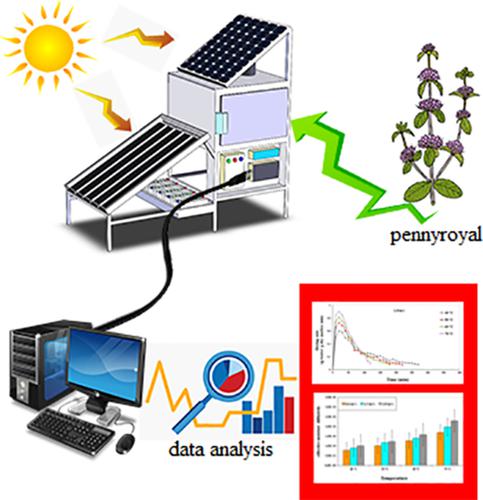当前位置:
X-MOL 学术
›
J. Food Process Eng.
›
论文详情
Our official English website, www.x-mol.net, welcomes your feedback! (Note: you will need to create a separate account there.)
Investigation of mass transfer, thermodynamics, and greenhouse gases properties in pennyroyal drying
Journal of Food Process Engineering ( IF 3 ) Pub Date : 2020-05-22 , DOI: 10.1111/jfpe.13446 Mohammad Kaveh 1 , Hamed Karami 1, 2 , Ahmad Jahanbakhshi 1
Journal of Food Process Engineering ( IF 3 ) Pub Date : 2020-05-22 , DOI: 10.1111/jfpe.13446 Mohammad Kaveh 1 , Hamed Karami 1, 2 , Ahmad Jahanbakhshi 1
Affiliation

|
In this research, kinetic analysis, energy, exergy, and greenhouse gases of a hybrid laboratory dryer (solar-hot air) are presented for pennyroyal. Drying was performed at input temperatures of 50, 60, and 70°C and air velocities of 0.6, 1.2, and 1.8 m/s. The effect of drying variables on moisture ratio, effective moisture diffusivity, specific energy consumption, energy utilization ratio, energy utilization, exergy efficiency, and exergy loss was investigated. The highest amounts of effective moisture diffusivity and specific energy consumption were 2.30 × 10−10 m2/s and 48.60 kWh/kg, respectively. Energy utilization and energy utilization ratio varied from 0.0064 to 0.0826 kJ/s and from 0.056 to 0.957, respectively. Exergy loss and exergy efficiency varied between 0.0037 to 0.0510 kJ/s and 0.2428 to 0.8731, respectively. In addition, by increasing the temperature and intake air velocity, drying rate increased and the emissions of greenhouse gases (CO2, SO2, and NOX) were reduced. Practical Applications: Modeling of the drying process is an important aspect of drying technology, especially in drying for industrial purposes. The aim of modeling is to select the most suitable drying method and the best operating conditions for obtaining the product. Some of the key issues in drying have been to reduce the price of the energy resources used, increase the drying efficiency, and improve the quality of the dried products. The concept of exergy is defined by the concept of reversible work. The concept of reversibility depends on energy balance and mass regardless of energy quality (exergy loss).
中文翻译:

pennyroyal 干燥中传质、热力学和温室气体特性的研究
在这项研究中,介绍了 pennyroyal 混合实验室干燥机(太阳能-热风)的动力学分析、能量、火用和温室气体。在 50、60 和 70°C 的输入温度和 0.6、1.2 和 1.8 m/s 的空气速度下进行干燥。研究了干燥变量对水分比、有效水分扩散率、比能耗、能源利用率、能源利用率、火用效率和火用损失的影响。有效水分扩散率和单位能耗的最高值分别为 2.30 × 10−10 m2/s 和 48.60 kWh/kg。能量利用率和能量利用率分别从 0.0064 到 0.0826 kJ/s 和从 0.056 到 0.957 不等。火用损失和火用效率分别在 0.0037 至 0.0510 kJ/s 和 0.2428 至 0.8731 之间变化。此外,通过提高温度和进气速度,干燥速度增加,温室气体(CO2、SO2 和 NOX)的排放量减少。实际应用:干燥过程的建模是干燥技术的一个重要方面,尤其是在工业用途的干燥中。建模的目的是选择最合适的干燥方法和获得产品的最佳操作条件。干燥中的一些关键问题是降低所用能源的价格、提高干燥效率和提高干燥产品的质量。火用的概念由可逆功的概念定义。可逆性的概念取决于能量平衡和质量,而与能量质量(火用损失)无关。干燥速度增加,温室气体(CO2、SO2 和 NOX)排放量减少。实际应用:干燥过程的建模是干燥技术的一个重要方面,尤其是在工业用途的干燥中。建模的目的是选择最合适的干燥方法和获得产品的最佳操作条件。干燥中的一些关键问题是降低所用能源的价格、提高干燥效率和提高干燥产品的质量。火用的概念由可逆功的概念定义。可逆性的概念取决于能量平衡和质量,而与能量质量(火用损失)无关。干燥速度增加,温室气体(CO2、SO2 和 NOX)排放量减少。实际应用:干燥过程的建模是干燥技术的一个重要方面,特别是在工业用途的干燥中。建模的目的是选择最合适的干燥方法和获得产品的最佳操作条件。干燥中的一些关键问题是降低所用能源的价格、提高干燥效率和提高干燥产品的质量。火用的概念由可逆功的概念定义。可逆性的概念取决于能量平衡和质量,而与能量质量(火用损失)无关。特别是在工业用途的干燥方面。建模的目的是选择最合适的干燥方法和获得产品的最佳操作条件。干燥中的一些关键问题是降低所用能源的价格、提高干燥效率和提高干燥产品的质量。火用的概念由可逆功的概念定义。可逆性的概念取决于能量平衡和质量,而与能量质量(火用损失)无关。特别是在工业用途的干燥方面。建模的目的是选择最合适的干燥方法和获得产品的最佳操作条件。干燥中的一些关键问题是降低所用能源的价格、提高干燥效率和提高干燥产品的质量。火用的概念由可逆功的概念定义。可逆性的概念取决于能量平衡和质量,而与能量质量(火用损失)无关。并提高干燥产品的质量。火用的概念由可逆功的概念定义。可逆性的概念取决于能量平衡和质量,而与能量质量(火用损失)无关。并提高干燥产品的质量。火用的概念由可逆功的概念定义。可逆性的概念取决于能量平衡和质量,而与能量质量(火用损失)无关。
更新日期:2020-05-22
中文翻译:

pennyroyal 干燥中传质、热力学和温室气体特性的研究
在这项研究中,介绍了 pennyroyal 混合实验室干燥机(太阳能-热风)的动力学分析、能量、火用和温室气体。在 50、60 和 70°C 的输入温度和 0.6、1.2 和 1.8 m/s 的空气速度下进行干燥。研究了干燥变量对水分比、有效水分扩散率、比能耗、能源利用率、能源利用率、火用效率和火用损失的影响。有效水分扩散率和单位能耗的最高值分别为 2.30 × 10−10 m2/s 和 48.60 kWh/kg。能量利用率和能量利用率分别从 0.0064 到 0.0826 kJ/s 和从 0.056 到 0.957 不等。火用损失和火用效率分别在 0.0037 至 0.0510 kJ/s 和 0.2428 至 0.8731 之间变化。此外,通过提高温度和进气速度,干燥速度增加,温室气体(CO2、SO2 和 NOX)的排放量减少。实际应用:干燥过程的建模是干燥技术的一个重要方面,尤其是在工业用途的干燥中。建模的目的是选择最合适的干燥方法和获得产品的最佳操作条件。干燥中的一些关键问题是降低所用能源的价格、提高干燥效率和提高干燥产品的质量。火用的概念由可逆功的概念定义。可逆性的概念取决于能量平衡和质量,而与能量质量(火用损失)无关。干燥速度增加,温室气体(CO2、SO2 和 NOX)排放量减少。实际应用:干燥过程的建模是干燥技术的一个重要方面,尤其是在工业用途的干燥中。建模的目的是选择最合适的干燥方法和获得产品的最佳操作条件。干燥中的一些关键问题是降低所用能源的价格、提高干燥效率和提高干燥产品的质量。火用的概念由可逆功的概念定义。可逆性的概念取决于能量平衡和质量,而与能量质量(火用损失)无关。干燥速度增加,温室气体(CO2、SO2 和 NOX)排放量减少。实际应用:干燥过程的建模是干燥技术的一个重要方面,特别是在工业用途的干燥中。建模的目的是选择最合适的干燥方法和获得产品的最佳操作条件。干燥中的一些关键问题是降低所用能源的价格、提高干燥效率和提高干燥产品的质量。火用的概念由可逆功的概念定义。可逆性的概念取决于能量平衡和质量,而与能量质量(火用损失)无关。特别是在工业用途的干燥方面。建模的目的是选择最合适的干燥方法和获得产品的最佳操作条件。干燥中的一些关键问题是降低所用能源的价格、提高干燥效率和提高干燥产品的质量。火用的概念由可逆功的概念定义。可逆性的概念取决于能量平衡和质量,而与能量质量(火用损失)无关。特别是在工业用途的干燥方面。建模的目的是选择最合适的干燥方法和获得产品的最佳操作条件。干燥中的一些关键问题是降低所用能源的价格、提高干燥效率和提高干燥产品的质量。火用的概念由可逆功的概念定义。可逆性的概念取决于能量平衡和质量,而与能量质量(火用损失)无关。并提高干燥产品的质量。火用的概念由可逆功的概念定义。可逆性的概念取决于能量平衡和质量,而与能量质量(火用损失)无关。并提高干燥产品的质量。火用的概念由可逆功的概念定义。可逆性的概念取决于能量平衡和质量,而与能量质量(火用损失)无关。


























 京公网安备 11010802027423号
京公网安备 11010802027423号